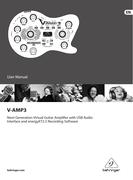
behringer.com
12 V-AMP3 User Manual
BRIT BLUES: Modeled on the JTM 45, the rst Marshall amp ever designed.
Extreme gain settings produce a highly compressed and really “dirty” sounding
distortion. Combined with a 2 x 12" speaker simulation, it produces impressive
Bluesbreaker sounds.
V-CRUNCH: This amp is ideal for modern blues or jazz. Its sound is subtle but
crunchy and dynamic.
CUSTOM BLUES: This simulation is based on a 1965 Marshall JTM 45
Bluesbreaker, but has more exibility of sound control. Turn the GAIN control to
the left and this simulation sounds like a Marshall; turn it to the right and it builds
a thick boutique distortion tone.
BRIT CLASSIC 50 W: This is also a Plexi, but we have extensively widened its
sound range. The sound controls on the original Marshall Plexi 50 Watt hardly
had any eect on the sound if distortion was high.
METAL
NUMETAL GAIN: This model is based on a 1994 Mesa Boogie Dual Rectier
Trem-O-Verb, featuring a modern high-gain sound that also comes over well
in a band context. The tone control is post-gain, which allows you to tailor
distorted sounds to great eect. This amp is perfect for heavy metal, but also for
Steve Lukather sounds. The best-known user of this amp is John Petrucci of the
progressive rock super group Dream Theater.
NUMETAL HD: This simulation is modeled on a Mesa Boogie Dual Rectier
head. Much like the Trem-O-Verb, this amp produces an even higher gain sound.
The tone controls are most eective with the gain knob cranked.
SAVAGE BEAST: Engl is well known for amps that really cut through. The Savage
120 in particular has built up a large following among guitarists. For some time
now, Ritchie Blackmore has been a major endorser of this German company,
and Randy Hanson, the best Hendrix since Jimi, also swears by this amp.
The unique feature of the Savage is its extreme power and is therefore highly
popular with heavy metal guitarists. Silent Force/Sinner guitarist Alex Beyrodt
has been an enthusiastic Engl user for years. An amp for making yourself heard!
CUSTOM HI GAIN: This sound goes back to a 1969 50-Watt Marshall Plexi
modied by Jose Arrendondo. Arrendondo was none other than Eddie Van
Halen’s guitar technician. The unique features of this amp are its ne mid-range
sounds and its ability to produce the ultimate in gain without making the sound
muddy. Warning: highly addictive!
BRIT HI GAIN: Compare this model with a Marshall JCM 800. Although the
original was renowned mainly for its distorted sounds, this amp also sounds very
good with low gain settings. It’s good at reproducing Steve Ray Vaughan’s and
Michael Landau’s guitar tone. In distortion mode, it sounds like Gary Moore in his
early days, but it’s also good for heavy metal.
MODERN HI GAIN: Modeled after a Soldano SLO, the tone control is post-gain
here as well, allowing the extremely distorted sound to cut through the mix.
The MODERN HI GAIN sound is ideal for playing Grunge, but is also used by
guitarists such as Steve Vai and Joe Satriani. If you’re playing a Les Paul-style
guitar, MODERN HI GAIN sounds best when you turn down the volume control on
the guitar a little.
NEW! ULTRAZONIC: This is a new, aggressive, in-your-face hi-gain sound similar
to the crunch channel of the Bugera 333XL. Detuned, palm-muted, fast rhythm
guitar ris are as clear and articulate as can be.
ULTIMATE PLUS: Those who nd the ULTRAZONIC too tame will nd enough
gain here for an overdose, and nearly endless sustain.
ROCK
NEW! ROCK 59SL: This is modeled on the sound of a Marshall 1959SLP,
which stands out for its extremely dynamic rock sound, dishing out fat clean
tone as well as solid crunch. This new amp model captures the liveliness and
responsiveness of the real thing.
BRIT CLASS A: This simulation is modeled on the Vox AC 30. This amp
was originally designed in the ’60s when guitarists wanted amps with
enhanced brilliance, a feature that Vox successfully implemented by means
of “revolutionary” bass and treble controls. Brian May and U2’s The Edge are
probably the best-known users of this sound.
NEW! HI BRIT 100: This is new model provides an assertive rhythm guitar
sound based on the Hiwatt Custom 100, which is most suitable for punchy
power chords. Think of Pete Townshend’s ingenious guitar work on The Who’s
“Pinball Wizard” to get an idea.
CUSTOM CLASS A: The model for this simulation is the Budda Twinmaster.
This Class A amp is renowned for its warm sound combined with irresistible tube
distortion. Although the original amp does not have a mid control, we have given
the capability of tailoring the midrange to suit your taste.
NEW! AMBER 120: Another new model, this time of the vintage distortion
sound typical of the Orange OD120. It is worth digging into the tone controls of
the Amber 120. If you crank the gain, the preamp tone controls greatly inuence
the sound.
CLASS A NORM: This amp is characterized by its mild distortion and highly
dynamic response. It is modeled on the Matchless Chieftain, a very expensive
hand-made amp.
BRIT CLASSIC: Based on a 1959 Marshall Plexi 100 Watt, this amp provides
a remarkable range of clean and crunch sounds thanks to its two channels
which can be run in parallel. It was used by many famous guitar players like
Jimi Hendrix, Eric Clapton, and Je Beck, to name a few.
BRITISH CLASS A 15 W: Another Vox model, based on the rst channel of an AC
15 from 1960. Unlike the AC 30, this amp had only one 12" speaker and produced
a warmer sound. Tip: to make this simulation sound as authentic as possible,
leave the BASS and MID controls in middle position and adjust the TREBLE
control only.
PREAMP BYPASS: In this setting, no amp simulation is selected. This makes it
possible, for example, to play through an external guitar preamp and only use the
eects or the speaker simulation. To activate the PREAMP BYPASS, press TAP and
TUNER simultaneously.
Fender, Vox, Marshall, Mesa Boogie, Gibson, Soldano, Matchless, Dumble, Budda, Tweed, Engl, Roland, Bugera,
Hiwatt, Orange and the names of musicians and groups are registered trademarks belonging to the respective
owners and are in no way associated with BEHRINGER.
Speaker Descriptions
The sound of any guitar combo depends largely on the type and combination of
speakers used. In the past 50 years there has been widespread experimentation
to nd out what type of speaker is best suited to any one specic guitar sound
and in what way the sound is modied when a certain speaker is combined
with others.
When you select an amp simulation, an appropriate speaker •
simulation is automatically activated (see graphic table below).
Otherwise, the authenticity of the sound could be aected by an unsuitable
cabinet – especially if you are using headphones. Naturally, you can combine
the amp simulations with other cabinets according to taste.
The character of a loudspeaker depends on many dierent variables.
The following table shows a list of all speaker cabinets on the V-AMP 3.
































